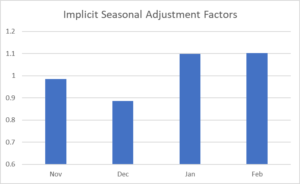January 13, 2022
No, I don’t expect calculations by statisticians in the Commerce Department to alleviate a real world problem, but there is an important point that many of us economist types could miss. We always work with seasonally adjusted data for obvious reasons. There are normal seasonal patterns to sales and hiring that we want to remove from our data.
If we didn’t make this adjustment, our data would show us plunging into recession every fall as workers in the tourism and construction industry lose their jobs. It would look like a boom every spring as these workers began to get rehired.
So all our data tries to remove these normal seasonal developments. The adjustments still can’t account for unusual weather, like a huge snowstorm in December or severe floods in the summer, but the adjustments help us to distinguish the underlying strength of the economy from what happens every year due to the changing seasons.
This can matter with respect to the supply chain backlog, because we are not moving seasonally adjusted cargo through our ports. We are moving containers of actual items. Insofar as our ports are constrained in their ability to move shipments, the constraint is not likely to change much over the various seasons.
It turns out the seasonal adjustments in retail sales are actually a big deal. I calculated implicit seasonal adjustments by comparing the ratio of unadjusted retail sales to the adjusted figures for the last pre-pandemic months. (I assume the actual adjustments used by the Commerce Department are sector-specific, so the final adjustment would depend on the mix of goods being sold.)

Source: Census Bureau and author’s calculations.
As can be seen, the adjustments for November, and especially December, are downward, meaning that we expect these months to have more sales than average due to to the holiday shopping season. The adjustments for January and February are sharply upward, since sales fall off after the holiday shopping season. The adjustments imply that we expect sales in January and February to be roughly 80 percent of sales in December. This means that we should be trying to get far fewer goods through our ports right now than back in November and December. (We should already have been seeing this effect in December, since it takes some time to get goods from the ports to store shelves.)
Anyhow, this means that even if there is no reduction in demand as shown in our seasonally adjusted data, there should be some reduction in pressure on our supply chains. We’ll see how much of the backlog this will clear up.







Comments